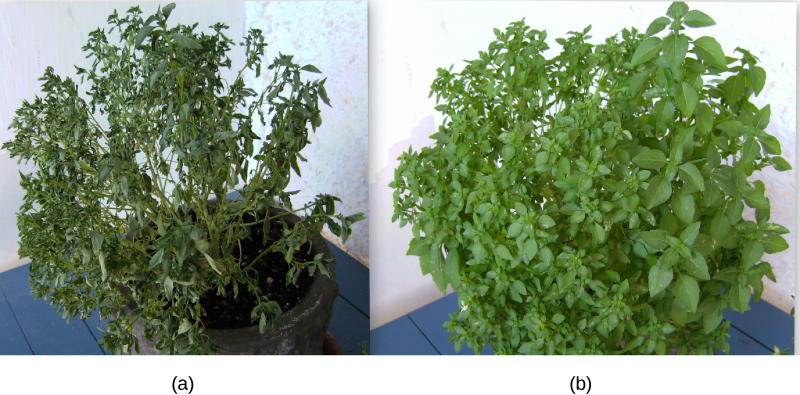| << Chapter < Page | Chapter >> Page > |
A plant can manipulate Ψ p via its ability to manipulate Ψ s and by the process of osmosis. If a plant cell increases the cytoplasmic solute concentration, Ψ s will decline, Ψ total will decline, the ΔΨ between the cell and the surrounding tissue will decline, water will move into the cell by osmosis, and Ψ p will increase. Ψ p is also under indirect plant control via the opening and closing of stomata. Stomatal openings allow water to evaporate from the leaf, reducing Ψ p and Ψ total of the leaf and increasing ii between the water in the leaf and the petiole, thereby allowing water to flow from the petiole into the leaf.

Gravity potential (Ψ g ) is always negative to zero in a plant with no height. It always removes or consumes potential energy from the system. The force of gravity pulls water downwards to the soil, reducing the total amount of potential energy in the water in the plant (Ψ total ). The taller the plant, the taller the water column, and the more influential Ψ g becomes. On a cellular scale and in short plants, this effect is negligible and easily ignored. However, over the height of a tall tree like a giant coastal redwood, the gravitational pull of –0.1 MPa m -1 is equivalent to an extra 1 MPa of resistance that must be overcome for water to reach the leaves of the tallest trees. Plants are unable to manipulate Ψ g .
Matric potential (Ψ m ) is always negative to zero. In a dry system, it can be as low as –2 MPa in a dry seed, and it is zero in a water-saturated system. The binding of water to a matrix always removes or consumes potential energy from the system. Ψ m is similar to solute potential because it involves tying up the energy in an aqueous system by forming hydrogen bonds between the water and some other component. However, in solute potential, the other components are soluble, hydrophilic solute molecules, whereas in Ψ m , the other components are insoluble, hydrophilic molecules of the plant cell wall. Every plant cell has a cellulosic cell wall and the cellulose in the cell walls is hydrophilic, producing a matrix for adhesion of water: hence the name matric potential. Ψ m is very large (negative) in dry tissues such as seeds or drought-affected soils. However, it quickly goes to zero as the seed takes up water or the soil hydrates. Ψ m cannot be manipulated by the plant and is typically ignored in well-watered roots, stems, and leaves.
Solutes, pressure, gravity, and matric potential are all important for the transport of water in plants. Water moves from an area of higher total water potential (higher Gibbs free energy) to an area of lower total water potential. Gibbs free energy is the energy associated with a chemical reaction that can be used to do work. This is expressed as ΔΨ.

Notification Switch
Would you like to follow the 'Biology' conversation and receive update notifications?